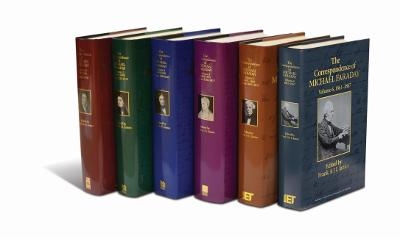
The Complete Correspondence of Michael Faraday
Seiten
2011
Institution of Engineering and Technology (Verlag)
978-1-84919-191-3 (ISBN)
Institution of Engineering and Technology (Verlag)
978-1-84919-191-3 (ISBN)
- Keine Verlagsinformationen verfügbar
- Artikel merken
Nineteenth century Britain. His discoveries of electro-magnetic rotations (1821) and electro-magnetic induction (1831) laid the foundations of the modern electrical industry. His discovery of the magneto-optical effect and diamagnetism (1845) led him to formulate the field theory of electro-magnetism, which forms one of the cornerstones of modern physics. These and a whole host of other fundamental discoveries in physics and chemistry, together with his lecturing at the Royal Institution, his work for the state (including Trinity House), his religious beliefs and his lack of mathematical ability, make Faraday one of the most fascinating scientific figures ever. All these aspects of his life and work and others, such as his illnesses, are reflected in his correspondence. This volume, in which just over 70% of the 841 letters are previously unpublished, covers the latter half of the 1850s and most of 1860.
Topics include: Faraday's work on regelation, the transmission of light through gold and his attempts to bring gravity into his general scheme of forces; the offer by Queen Victoria, and his acceptance, of a Grace and Favour House at Hampton Court; his advice to Trinity House, the Board of Trade and the Royal Commission on Lighthouses; his investigation of the deterioration of the stonework of the relatively new Houses of Parliament; the conservation issues surrounding the National Gallery's pictures; and his appointment by Emperor Napoleon III to be a Commander of the Legion of Honour. Major correspondents included the Astronomer Royal G.B. Airy, the new Secretary of Trinity House P.H. Berthon, the Birmingham glassmaker J.T. Chance, the French chemist and politician J.B.A. Dumas, the Assistant Secretary of the Board of Trade T.H. Farrer, the German mathematician Julius Plucker, the Cambridge trained mathematical natural philosophers James Clerk Maxwell, George Gabriel Stokes and William Thomson, Faraday's colleague at the Royal Institution John Tyndall and the Swiss chemist Christian Schoenbein whose daughter died while in London.
Topics include: Faraday's work on regelation, the transmission of light through gold and his attempts to bring gravity into his general scheme of forces; the offer by Queen Victoria, and his acceptance, of a Grace and Favour House at Hampton Court; his advice to Trinity House, the Board of Trade and the Royal Commission on Lighthouses; his investigation of the deterioration of the stonework of the relatively new Houses of Parliament; the conservation issues surrounding the National Gallery's pictures; and his appointment by Emperor Napoleon III to be a Commander of the Legion of Honour. Major correspondents included the Astronomer Royal G.B. Airy, the new Secretary of Trinity House P.H. Berthon, the Birmingham glassmaker J.T. Chance, the French chemist and politician J.B.A. Dumas, the Assistant Secretary of the Board of Trade T.H. Farrer, the German mathematician Julius Plucker, the Cambridge trained mathematical natural philosophers James Clerk Maxwell, George Gabriel Stokes and William Thomson, Faraday's colleague at the Royal Institution John Tyndall and the Swiss chemist Christian Schoenbein whose daughter died while in London.
Frank A J L James is Professor of the History of Science at the Royal Institution, President of the British Society for the History of Science and past President of the Newcomen Society. He has written on nineteenth century physics and chemistry in their various contexts and with Geoffrey Cantor and David Gooding wrote the biography Michael Faraday Macmillan/Humanities Press). He has also edited a collection of essays on the history of the Royal Institution The Common Purposes of Life (Ashgate).
| Erscheint lt. Verlag | 1.10.2011 |
|---|---|
| Verlagsort | Stevenage |
| Sprache | englisch |
| Themenwelt | Naturwissenschaften ► Physik / Astronomie ► Elektrodynamik |
| Technik ► Elektrotechnik / Energietechnik | |
| ISBN-10 | 1-84919-191-3 / 1849191913 |
| ISBN-13 | 978-1-84919-191-3 / 9781849191913 |
| Zustand | Neuware |
| Haben Sie eine Frage zum Produkt? |
Mehr entdecken
aus dem Bereich
aus dem Bereich
eine Einführung in die Gleich- und Wechselstromtechnik
Buch | Hardcover (2024)
Hanser (Verlag)
CHF 48,95
Grundlagen und praktische Anwendungen
Buch | Hardcover (2022)
Hanser (Verlag)
CHF 48,95


